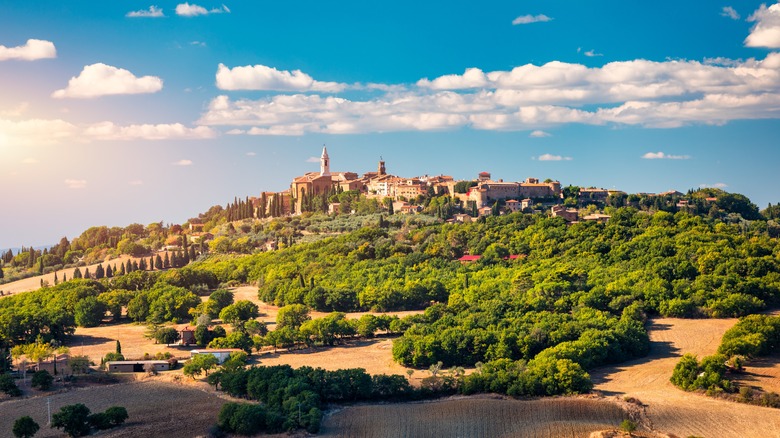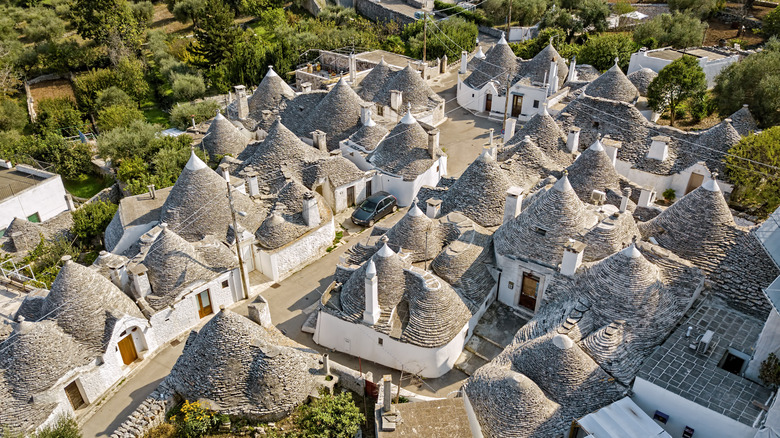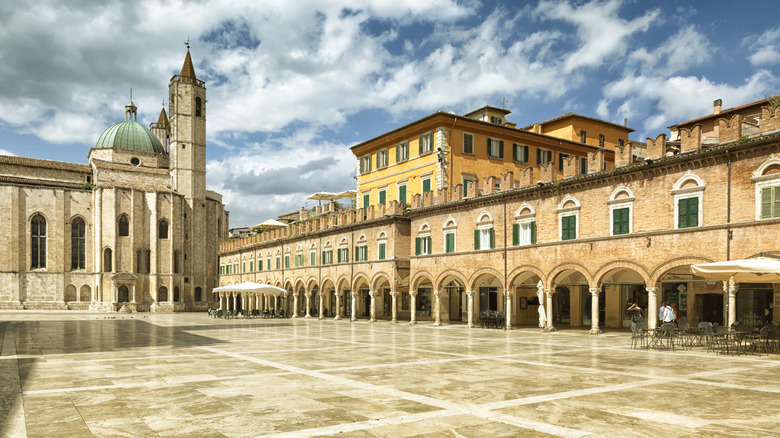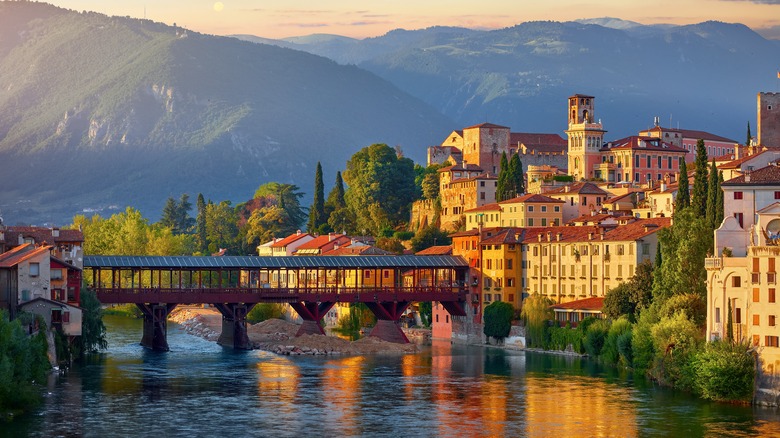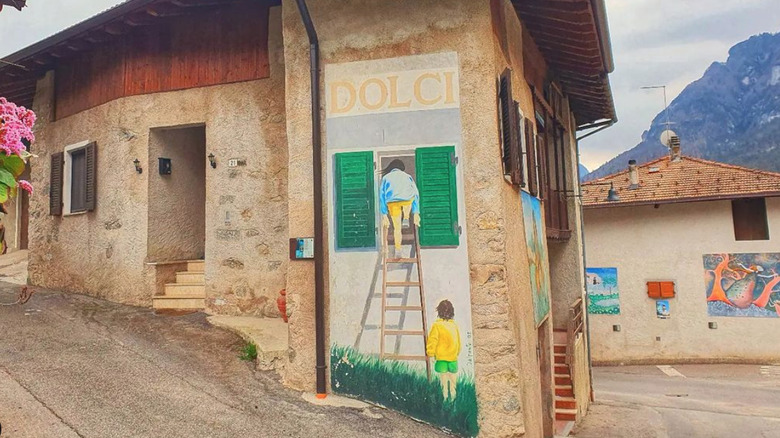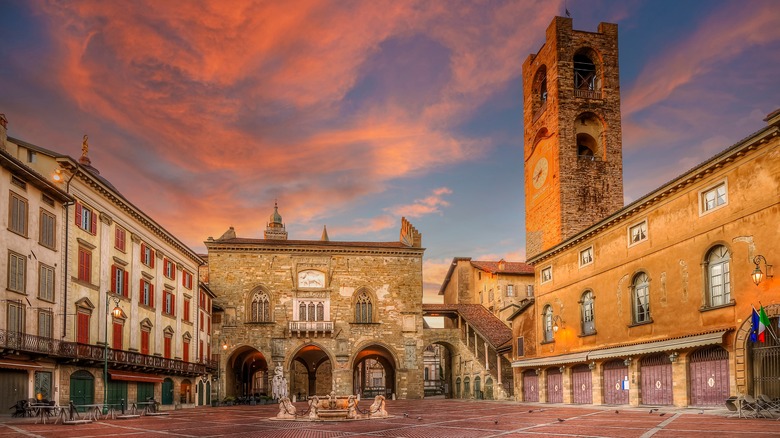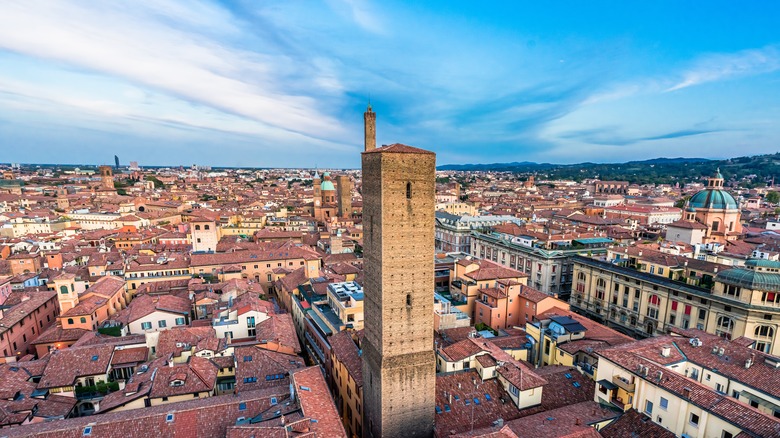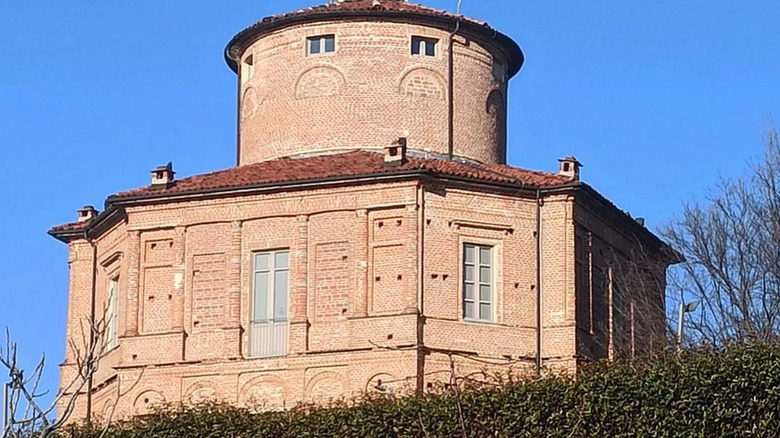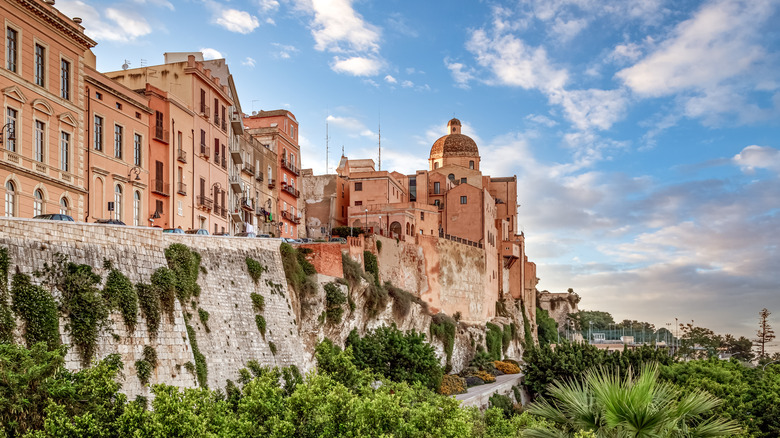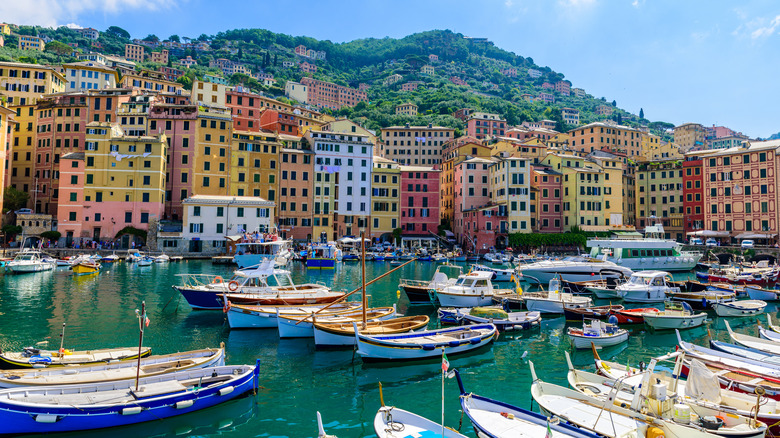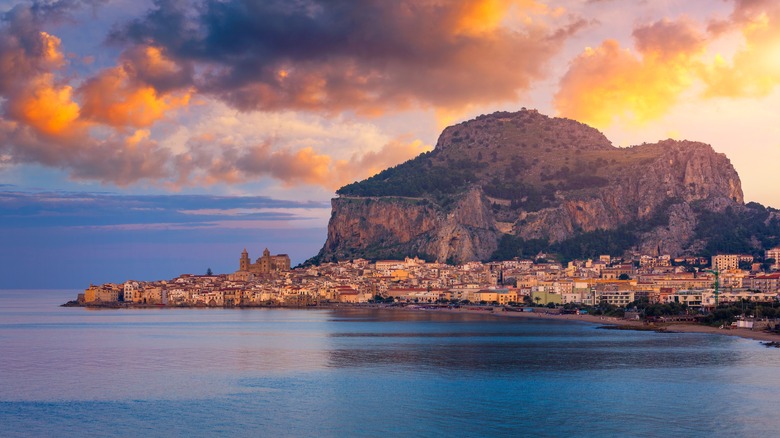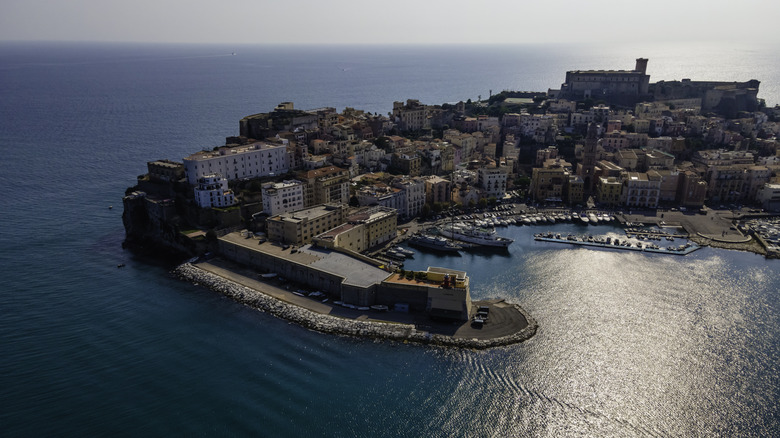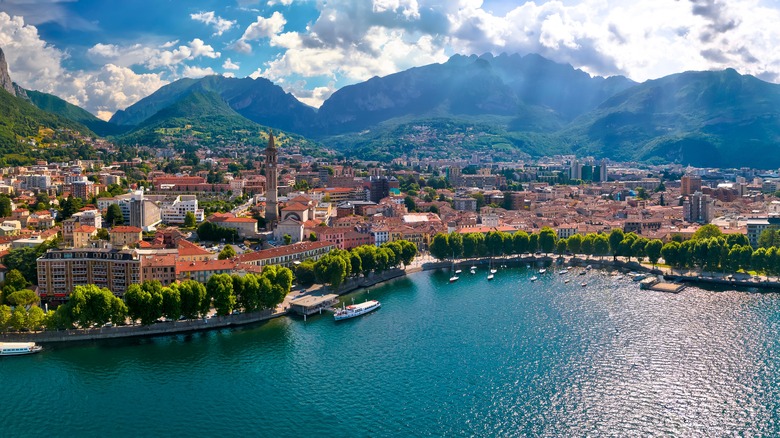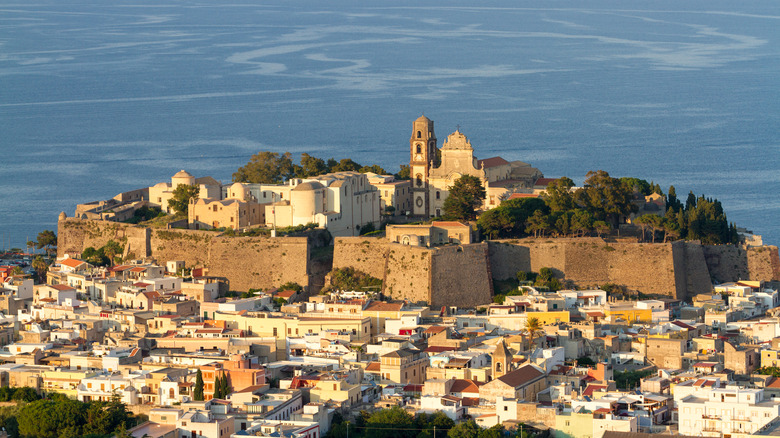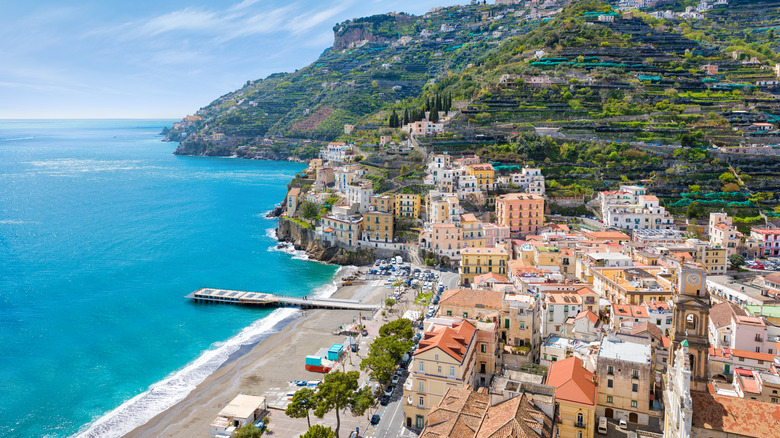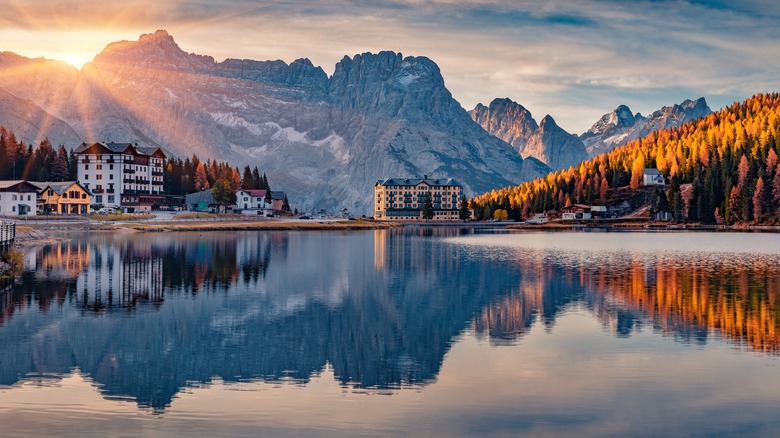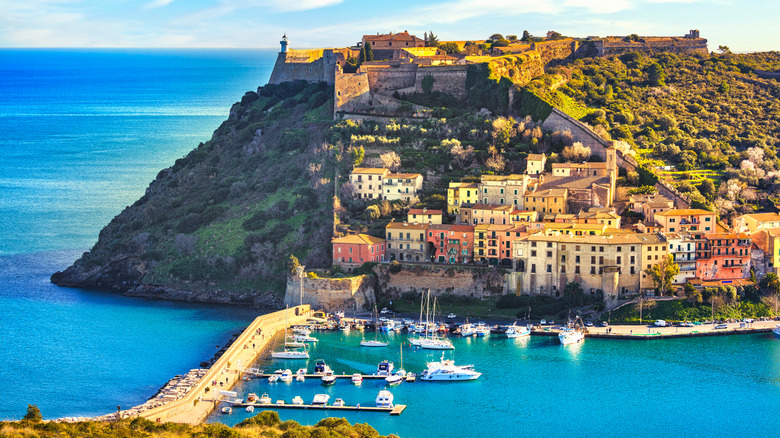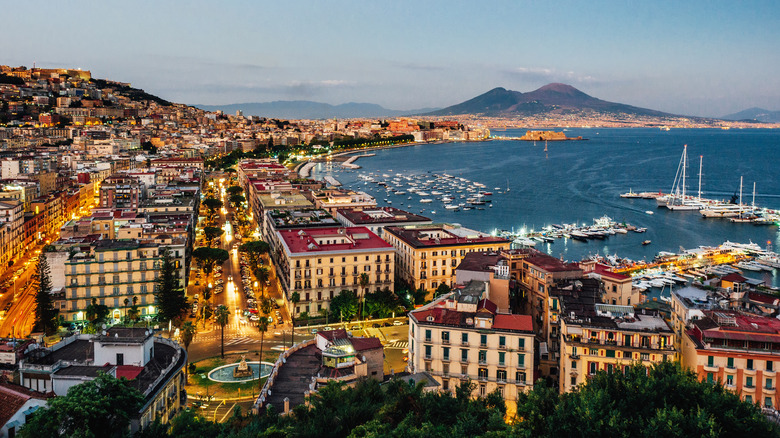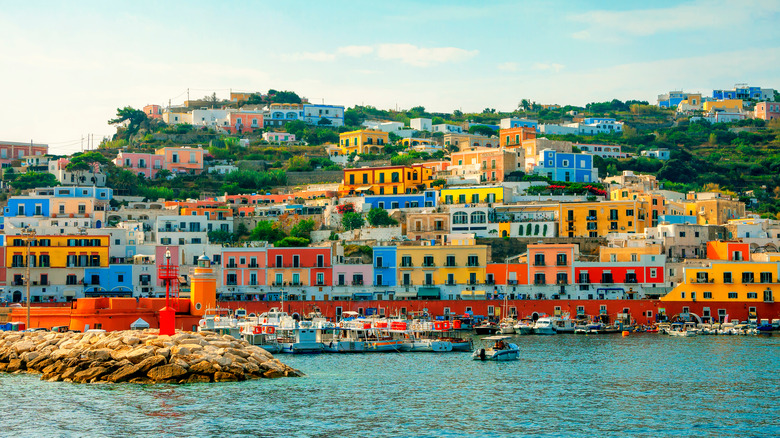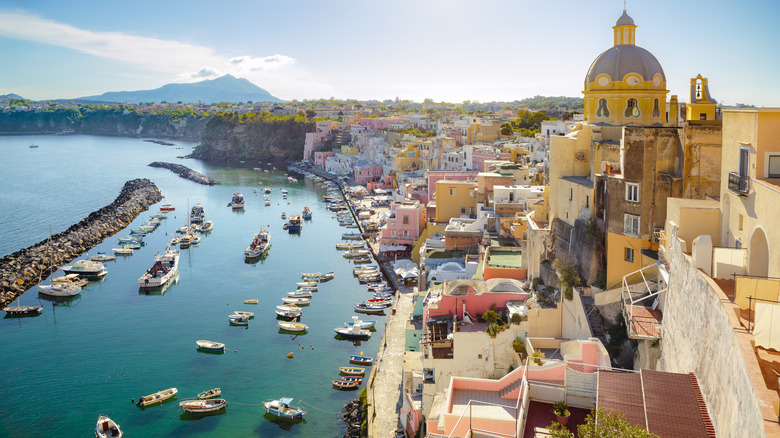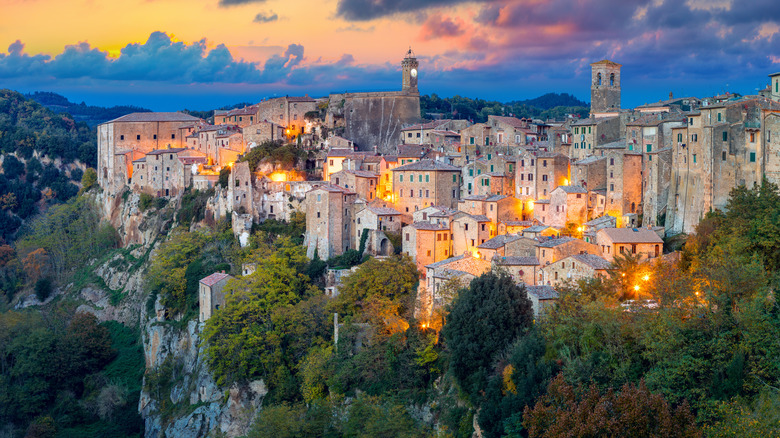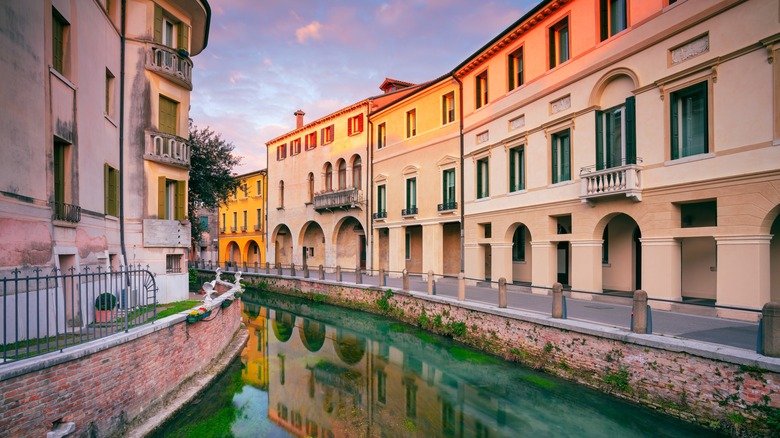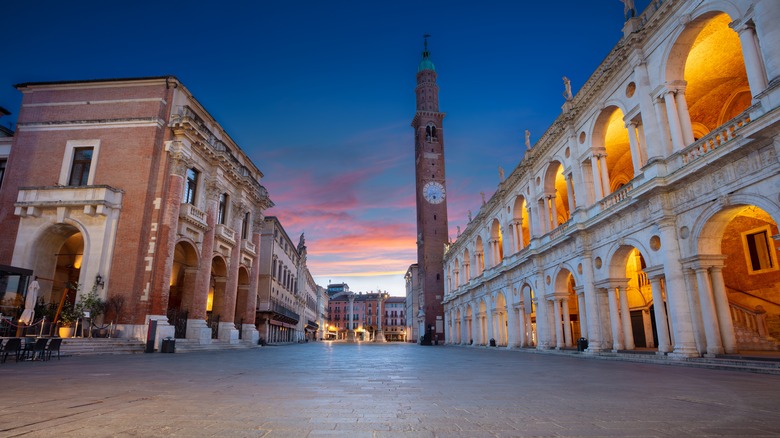22 Underrated Tourist Destinations In Italy
A country that is high on the wish list of travelers the world over, Italy is a scintillating destination. What's not to love about this European nation, shaped, for anyone that has an overactive imagination, like a thigh-high boot that appears to be kicking a slice of something vaguely triangular (that's the island of Italian Sicily, but the way)? Tons of people feel that way, and, pre-pandemic, Italy was welcoming more than 50 million international tourists per year. This is where to find delectable food from north to south, beautiful rolling countryside with fresh produce and exquisite wines, beaches that will make your heart melt, incredible history that is still represented in living structures, fabulous artistic works in world-renowned museums, striking architecture that represents centuries of achievement, and a vibrant sense of living life for simple pleasures.
Italy is a place to visit any time of the year, and many travelers that come here will descend on a few tried-and-tested places that can't be missed. There's Rome, with its Colosseum, iconic fountains and monuments, and grand stature as the core of a former empire. Florence is where to linger over incredible art and picturesque bridges, while Venice appears like some fantasy land torn from the pages of a fiction book, with homes straddling canals and roads nowhere to be seen. Yet, for every sure-fire hit in Italy, there exist plenty of other places off the tourist radar that still promise an amazing experience.
Alberobello
Any visitors who want to feel as though they have entered another dimension should plan to drop by this small town on the heel of Italy's boot, in the country's southeast. Here, the houses have distinctive cone-shaped roofs and almost appear lifted from the medieval hamlet, or some epic Middle Ages tome where the homes are inhabited by a tribe of compact, yet noble, warriors that will proudly, heroically defend their town against all enemy forces. The houses have blindingly white bases but it is their roofs that stand out, conical and sharply pitched, like a Hershey's Kiss, and covered in tiles.
While the houses look almost museum-like in their form, preserved for centuries this way, they are very much living abodes, where the townspeople reside. Known as "trulli" (the plural of "trullo"), these homes are made of chunky limestone blocks from the surrounding area, and use an ancient building scheme in their assembly. Such is the historic significance of this architectural wonder, the buildings are on the UNESCO World Heritage site list.
Ascoli Piceno
This town is located about three hours northeast of Rome. While visiting here, you'll see what is most remarkable about Ascoli Piceno are its beautiful travertine buildings — solid, sun-baked, and stoic. Wander around the town and you will find gorgeous piazzas where locals flock for a sip of coffee or a chance to catch up, and look up at the ancient churches that speak to the destination's rich background. This was a Roman stronghold more than 2,000 years ago, known back then as Asculum, though more recently it was notable as a key base of resistance against the Germans in World War II.
One sight that can't be missed is the Palazzo dei Capitani del Popolo, set on the edge of the equally hypnotic Piazza del Popolo. The complex brought together three medieval edifices and was formed as a forum to represent the townspeople, though it subsequently burned down and was reconstructed in the mid-1500s, with statues, courtyards, internal false ceilings, and a soaring central tower. Elsewhere, travelers will delight in the bridges, forts, cathedrals, and churches all around, as well as gourmet specialties like local stuffed olives.
Bassano del Grappa
Not far from Venice, only an hour's drive from its airport, this town is famous for a drink that appears in its name. Made from the less desirable parts of a grape — stems, seeds, skins — that serve no purpose in the process of making wine, grappa originates from grapes that grow in Italy. It's a powerful spirit, but still very popular in households around the country, a great aperitif or digestif at dinner. The town has a healthy population, approximately 40,000 inhabitants, and lies between grand plains and the foothills of the Alps. The architecture here reflects the location, with the sorts of arcades that are commonplace in this region mixing with wooden balconies that are a hallmark of the Alpine vernacular.
Visits here will typically stop at the Ponte degli Alpini, a picturesque covered bridge that spans the Brenta river, and was designed by legendary Italian architect Andrea Palladio. At one end of the bridge, a small museum looks at the military history of the area, with photographs and items from World War I, and World War II, while the nearby Museo della Grappa offers visitors an insight into the potent libation.
Balbido
This village in the mountains, in the northern part of the country as it extends toward Austria and Switzerland, has all the Alpine charm that one would expect. Located in the Alto Adige region of Italy, it's populated with sturdy houses dotted around hilly streets, but what sets it apart from a typical mountain village is the proliferation of art, specifically murals. Walking around Balbido is like wandering about an open-air art museum, not just for the uniquely preserved homes here, but the wealth of painted walls.
Saunter round the streets and you will see portrayals of everyday scenes that resonate with the residents of the village — a depiction of a man carrying logs on his back, an ox strolling on a field, workers toiling in fields, men on horseback tearing through open countryside, and other, more abstract artwork that is no less thrilling. The overall experience is incredibly unexpected and immensely rewarding.
Bergamo
It might only take an hour to get from Milan to Bergamo, but the sensibilities between this delightful town and Italy's center of fashion and finance are wildly different. Bergamo is split into two parts, the upper and lower town, or the Città Alta and Città Bassa. To get to the higher part, travelers can board a funicular that climbs a slope in excess of 50 degrees, and that is more than a century old, a refreshingly anachronistic way to get around the city. The upper town is enclosed by sturdy, high Venetian walls, great ramparts for strolling, especially at sunset, and is where to find the pretty main square Piazza Vecchia, the city's pulsing core with its iconic fountain.
This is also where to find the historic Angelo Mai Library, the tower known as Campanone, which offers spectacular city views, and the dazzling Palazzo Nuovo and Palazzo Vecchio. The lower part of Bergamo is charming, with fine vistas of the upper part, pretty Art Nouveau architecture, and access to the Alta Via delle Grazie walking path, that heads out toward mountains and lakes.
Bologna
Standing in Piazza Maggiore, a key square in the heart of the old part of this northern Italian city, visitors might feel like they have traveled back in time. All around, medieval buildings present themselves, and combined with the city's vast web of porticoed streets — thoroughfares where the sidewalks sit under colonnades, offering shade and respite in all weather conditions — a deep sense of history pervades any walk around town. These porticoes are of such cultural significance that they appear on the UNESCO World Heritage list, and they will be a constant presence on any expedition around town.
Visitors will encounter museums that look at the region's archaeological and medieval past, or fine shrines such as the 14th-century Basilica di San Giacomo Maggiore, which mixes Gothic, Renaissance, and Romanesque influences. The university here is also the oldest on the continent, adding more prestige to the city, while the canals that add visual disruption to the cityscape, date to the 12th century.
Bra
This pretty town is especially alluring during the colder months, when snow-capped hills and mountains supply a picturesque backdrop. Located southeast of Turin, it sits among the Roero hills, and has a past strongly entwined with the Roman Empire. It's certainly an enjoyable place to wander, with Baroque architecture visible throughout the town's streets and squares, including on the front of the town hall, and the ornate Church of Santa Chiara.
Another notable building sits high up, on the Monte Guglielmo, the tallest peak of Bra, and is shaped as an octagon with a circular tower on top. Though it might look like the house of an Italian noble, this is actually La Zizzola — House of Braidesi, one of the newest museums in Bra, with a focus on exploring and explaining the past of this alluring town and the area beyond. Bra also plays an important role in the country's food scene, and was the host, in 1997, of Cheese, the first dairy products fair that was staged by the globally famous Slow Food movement. Cheese continues to be celebrated here, with an annual festival on the food now part of Bra's regular calendar.
Cagliari
At the bottom part of Sardinia, a sizeable Italian island that sits in the middle of the Mediterranean Sea, Cagliari is an amazingly atmospheric town. The first stop here tends to be the Castello, one of the sections of the town, a citadel that sits up on a hill and represents the medieval era preserved to stunning effect. Come here and you will see buildings that look like might crumble, tight alleys where clothes hang out to dry from window rods, or pretty planters that add splashes of greenery, while palaces round out the experience.
Two watchtowers are not to be missed, constructed in the 14th century and sometimes open for visits — the views from them are magnificent. Also worth dropping by is the Museo Archeologico Nazionale di Cagliari, an incredible repository of historic treasures, with some astounding stone carvings on display. The city's past is also evident in the Roman amphitheater here, built more than 1,7000 years ago. Cut into the rocky slopes on the side of a hill, it was where gladiators fought back in the day.
Camogli
Brightly painted buildings stand out along the waterfront of this town that's not far from Portofino, the quaint fishing village that has become a chic seaside getaway. It's an arresting, visually exciting sight, to see the vibrant serenade of tall, tightly packed edifices lining the seafront, huddling around beaches that also fill handsomely during the summer months. Camogli is a village with a strong tradition in the art of clothing production, with weaving, dying of textiles, and the meticulous discipline of creating yarn all commonplace fields of employment.
Wander around the streets and you will notice a wealth of trompe l'oeil building faces, painted schemes that sometimes recreate pedestals and window shutters. One of the most outstanding places to see is the Basilica Minore di Santa Maria Assunta, located right on the water and next to the port area. What makes it unique is its facade, curving and cutting, all angles and geometry with a soaring tower that is one of Camogli's defining images. As fascinating, Dragonara Castle dates from medieval times and served as a coastal defense outpost.
Cefalù
On the north coast of Sicily, and east of its main town Palermo, the village is dominated by a giant cliff. Known by a number of names over the centuries, it is a destination where the mammoth rock can't be escaped. Rising hundreds of feet into the air, it was home to an ancient temple and today it looms over Cefalù like a sentry.
Of the manmade attractions here, few compare to the Duomo, the imposing cathedral with twin towers that looks robust enough to double up as a military outpost. The interiors are mouth-watering in their execution, with a huge mosaic of Christ, soaring columns, and intricate stone carvings throughout. Medieval buildings in the village also attest to its long history, and the Palazzo Maria makes for a fantastic photo subject, while Islamic influences in the architecture here are plain to see. There is also plenty of Baroque workmanship, especially around the town's center, which radiates out to streets and squares. And eagle-eyed fans of the show "White Lotus" might recognize the town's beach for scenes that were shot here.
Gaeta
This pretty beach town sits on the edge of a craggy peninsula and is an easy getaway from Rome, reached by car in two hours from the Italian capital. The center of the town certainly has a historic feel to it, with oodles of medieval architecture. Fans of religious buildings are in for a treat, with a healthy assortment of churches here, and the variety among their influences makes each one a visual feast — some showcase the Gothic era, others are notable for the Baroque, Arab, and even French characteristics.
But a visit here isn't all about the buildings, and travelers will be able to find comfort at some of the town's sumptuous beaches. The largest, and most popular, is Serapo, a broad slash of sand, and deep as well so there is space to unwind. For more natural delights, take some time to explore Parco Naturale Monte Orlando, at the top of the headland with hiking trails and fine water views.
Lecco
Sitting on the southeastern flank of Lake Como, this town is as much about the water in front as the hills behind it, part of the Orobie mountains. The village has fine Neoclassical architecture throughout and is a beautiful spot to walk around, not just for the buildings, but the setting by the lake. In an earlier incarnation, the village served as a fortified bastion that helped to protect trade routes, and that role is evident on the Azzone Visconti Bridge, a muscular span from the 1300s built with eight arches, and bookended by towers from which troops could defend the bridge.
Look for the chapel on it, not something that you typically see on a bridge. Another vestige of the Visconti family is the Torre Viscontea, in old Lecco, the only part of a powerful castle with defensive structures that still remains. And for travelers that need to stretch their legs more, hiking in the hills on the outskirts of Lecco is world-class.
Lipari
One of the Aeolian islands, a strand of isles north of Sicily, Lipari offers a heady mix of culture and relaxation in a beautifully bundled package. The easiest way to get here is by ferry from Sicily, though there are longer ferry rides directly from ports on the mainland. Though the island isn't huge, the best method for exploration is via a scooter — the Aeolian islands are volcanic, and its slopes can be taxing on the legs.
To get a good sense of the area, head up to Chiesa Vecchia (or Old Church) in the Quattropani part of the island, from where the views are inspiring; you'll see other nearby islands of Filicudi, Panarea, and Stromboli, and the sunsets are to die for. Hikers will also enjoy striking vistas from the top of Monte Chirica, the highest point of Lipari. Be sure to stop at the churches sprinkled around the island, and the Castello di Lipari, where the Bernabò Brea Museum is a gem of archaeological illumination, with Greek artifacts on display. Of the many fabulous beaches, Spiaggia Bianca stands out for the blinding white sand and pumice that contrast with the clear turquoise sea.
Minori
This charming Amalfi Coast town may not be as famous at Positano or Ravello, but is equally appealing. Many years ago, the town was called Rheginna Minor, and the name has since evolved to its current moniker. Much like the other Amalfi towns, the most rewarding aspect of a visit is to simply drink in the atmosphere of being on the southern Italian coast, with the fragrant sea air suffusing the experience with a sense of escape. Minori has a lovely core, and even if it has a strong tourism pull, it manages to retain the feel of a fishing village, from the small cottages around town to the narrow, bright lanes.
The Villa Marittima Roma, tucked into the heart of town, is almost 2,000 years old, a grand home that was used as a summer residence of a Roman noble. The Amalfi Coast is known for its citrus, and Il Sentiero dei Limoni, which translates to the Lemon Path, is a walking track from Minor to neighboring villages, where lemon trees are abundant along the way, and the views of the coast will stick in your memory long after you've left.
Misurina
Sometimes also known as Lake Misurina, this town in the Dolomites sits next to a small lake and promises visitors beautiful clean air and great hiking nearby. It's a popular winter spot, partly because of its proximity to the skiing haunt Cortina d'Ampezzo, one of the best ski destinations in the world, and also draws Austrians thanks to its proximity to the border with Austria. Some come here for a truly restorative vacation, with the low humidity and crisp atmosphere acting as salves to energize the spirit. The village itself is tiny, in essence, one main road that hugs the lakeshore, with a few smaller roads branching off it, but its Lilliputian stature ensures that visitors get out and about in the surrounding countryside.
Mountain hiking can be both easy and challenging, with some routes featuring "vie ferrate" (steep trails where cables, ropes, and ladders help hikers navigate the trickier sections), and information boards on some walks describe the area's significance during the sorties and battles of World War II. Misurina is a great jumping-off point for the hike around Tre Cime di Lavaredo, one of the most famous walks in the Dolomites, with three giant shards of rock that erupt from the ground like giant jagged teeth.
Monte Argentario
Tuscany isn't all rolling hills and beautiful pastoral landscapes, as evidenced by this coastal peninsula that is south of Florence and northwest of Rome. On a map, it looks a little unnatural, like a blob tethered to the mainland by a few slim strips of land, but in reality, this is a gorgeous part of the country. Visitors will extol the fine beaches all around the headland, with plenty of places to swim, as well as tucked-away coves that create sublime marine hideaways. A couple of the towns here pull in most of the travelers.
Porto Santo Stefano, on the northern part of Monte Argentario, has a fine promenade that is a great place for a seaside stroll, and the Fortezza Spagnola (translating to "Spanish Fortress") is a former historic defense armament that now hosts exhibitions. On the southern coast, Porto Ercole is a charming village with tight, winding alleys and the striking Sant'Erasmo church, with Baroque exteriors and a history that reaches back more than 1,500 years. For some relaxation, head to Feniglia, a beach that extends many miles and that connects Monte Argentario to the mainland.
Naples
Southern Italy's main city is a chaotic, noisy, wildly energetic place, and recently, that sense of buzz increased when the city's soccer team won the top Italian division title this year for the first time in three decades. Of course, many travelers will know of the city's incredible pizzas — Neapolitan pies are famous the world over — but the city is also revered among Italians for the best coffee in the country, often created in a small metal contraption that looks like an odd teapot.
Naples might not have the prim, polished look of other cities in the country that lure tourists, but its narrow alleys and sense of urban decay give it a sense of realism and grit that is both refreshing and appealing. Of course, there are also sights to see here, such as the Duomo di Napoli, a grand structure that showcases Gothic influences, and the Castel Sant'Elmo, a hilltop fort that is more than six hundred years old, and that offers up impressive views across the city and beyond.
Ponza
West of Naples in the Tyrrhenian Sea, this volcanic island, part of the Pontine archipelago, is a great getaway. The first impression is certainly warming to the spirit, with houses daubed in pinks, blues, and reds, and whites sitting near the port, a tableau that defines this as a pretty island escape. The main town certainly has its share of history running through its lanes and alleys, but the urban part quickly cedes to nature, with donkey tracks radiating out from it and into the surrounding countryside and hilly island core.
Ponza recurs in the mythological stories, including that of Ulysses, and it's been a dominion of Greeks, Romans, and Etruscans, with ancient ruins dotted around its terrain. What draws many visitors is the surfeit of nature, from forested interiors to mysterious caves, from gorgeous curls of beach to sultry, clear turquoise seas. Be sure to spend time at Chaia di Luna, a crescent beach backed by sheer white cliffs, a sight for the ages (and your Instagram feed).
Procida
A small island in the Bay of Naples, this charming destination is far less famous than chic Capri, which sits a short distance to the southeast. Procida has a few different sections of interest to a visitor, including an old historic center, a part that is a classic fishing village, and a port. The heart of the island is Piazza Olmo, a central square where lanes branch off, like spokes on a wheel, and from here any point on the island is a short walk away.
The island's many charms haven't been lost on the country's film industry, and Procida plays hosts to movie and TV crews regularly — a defining scene of the film "Il Postino" takes place on Pozzo Vecchio beach here, a cove of turquoise water backed by high cliffs. For some classic seafront imagery, travelers can wind their way to Marina Corricella, a fishing village where tight alleys, fishing boats, and large nets drying on the docks appear as they have for many centuries.
Sorano
This old Tuscan village set between Florence and Rome truly inhabits its surroundings — it is built into the rocky landscape. A town that was an important center in the Etruscan period, and, at times, that still feels as though it resides in that era, it is set high up on cliffs, and molded into the natural sediment, with paths that run through quarries. At some point in its history, the village played a strategic defensive role, and ramparts are evidence of such a past, with access into the town via defensive gates.
These entryways, known as Porta di Sopra and Porta dei Merli, allow visitors to eventually get to the Palazzo Orsini, an impregnable stronghold that withstood advances from the Papal state. Today the fort is open for visitors and is home to an old castle and a museum that traces its rich history. One sight not to miss is the Vie Cave, a web of trails, many above ground but others that are subterranean, used by locals to navigate the area without detection.
Treviso
Fans of the Italian dessert tiramisù can order a portion here and pay homage to it while taking mouthfuls — it is believed that the sweet treat was invented here. This town on the banks of the river Sile and by the Buranelli Canal, not far from Venice which sits to the south, has fine aged architecture and a pretty waterside setting. This is a great destination for visitors that like to just wander and soak in the atmosphere, and Treviso has lovely gardens and walking arcades, as well as a main drag Via Calmaggiore filled with old-style delicatessens.
One of the most historic buildings here is the Palazzo dei Trecento, more than 700 years old, and the former seat of local government. Another quintessential stop worth making in this simple, charming destination, is the Pescheria, or fish market, close to the water and a vibrant hub that thrums with the life of commerce.
Vicenza
One of the most famous architects of all time, and whose name is synonymous with a specific type of building design, Andrea Palladio lived from 1508-1580, spending his final years in this town not far west of Venice. While his work is revered throughout the globe, with plenty of examples of it around the country — and there are many imitators of his style dotted around the planet — this town has an amazing wealth of structures designed by him.
Among the highlights is the Palazzo Iseppo da Porta, designed for a friend of his and notable for its grand facade, split into three parts, and one of his most iconic buildings, the Villa Almerico-Capra, often referred to as Villa La Rotonda, a building that has no obvious front because all four sides are considered facades, a masterpiece of design and creativity. The city even has a walking tour so devotees of this Italian great can plot a route to take in some of his masterpieces.
